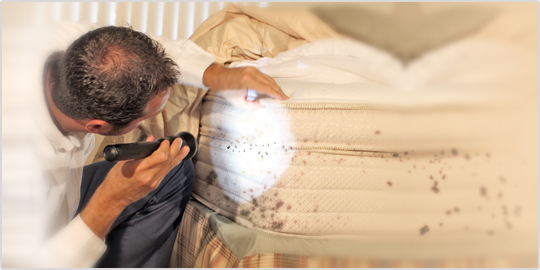
INSPECTION
It begins with a customer interview, followed by a thorough visual inspection for pest IDENTIFICATION and DETERMINATION of a course of action. Inspection includes mattress tufts, seams and areas around the buttons, box spring & bed frame, headboard, nightstands, adjacent baseboards, pictures, etc. The pest professional makes thorough notes of all findings and always invites the customer to participate in the inspection process. He then develops a graph and site plan that outlines his findings.
Customer Prep
Linen removal and laundering
The customer removes all bedding (sheets, pillowcases, mattress pads,
blankets, comforters, bed skirts, etc.) so the technician can treat. Customer places items directly in a plastic bag,
then seals the bag before moving it to the laundry.
- Launder washable bedding in HOT water, using the highest heat temperature possible to dry.
- Dry clean items, like draperies, comforters and bed skirts, per manufacturer’s label. Note:It is possible to spread bed bugs when infested items are taken to the dry cleaners. As a courtesy, please bag these items.
- Items, like draperies, may be treated by the technician if requested by the customer (release required).
Miscellaneous item removal
The customer thoroughly checks each item for bed bugs as he removes contents from closets, dressers, nightstands, etc. He places items in plastic bags or bins with tops, seals and leaves bags/containers in the room so they can be treated. The customer also discards or places in sealed bags/bins all paper products, such as cardboard boxes, shoe boxes, personal papers, old newspapers, magazines and similar items, that are in the infested rooms so they can be treated.
Action Plan
Vacuuming
A critical step! The customer thoroughly vacuums all infested rooms, especially areas where baseboards abut carpet/flooring. He vacuums mattresses, box springs, furniture, closets, shelving, etc., focusing on cracks, crevices, mattress buttons/tufts, etc. Customer immediately places vacuum bag or canister contents in a sealed bag and disposes of debris in an outside trash receptacle.
CONTROL & PREVENTION MEASURES
Before beginning his work, the pest professional verifies that the room has been prepped for treatment by the customer. The intensive I.P.M. steps are as follows:
Preparation
The technician pulls the bed away from the wall and then removes the mattress from the box spring. He makes a plan for treatment.
Liquid application #1
With a mattress & fabric tip (low flow) on the Tornado and Temprid, the technician treats the mattress, box spring (including the area under the ticking) and bed frame. Now, he does a crack & crevice treatment on the headboard, nightstands, dressers, armoires, luggage racks, luggage exteriors and upholstered furniture.
Liquid application #2
With a crack & crevice wand (high flow) on the Tornado and Temprid, the technician treats where carpeting abuts the baseboards or wall surfaces (including the area inside closets), around door frames and where crown moulding abuts wall and ceiling surfaces.
Wall Void Injection
The technician uses a drill with a 3/32″ bit to drill small openings just above the baseboard every 16″ in the wall adjacent to the headboard/bed and other walls, as needed, where pockets of infestation exist. With a wall injection tip on the Tornado, the technician injects Temprid (2-4 second blast with a 9 to 3 o’clock rotation) into each void. He then patches the holes with white interior caulk.
Aerosol Treatment
With artwork and other moisture sensitive items (clock radio, books, etc.) in a plastic bag, the technician cinches the opening of the bag around 5 a stinger/straw tip and, using 565, emits a one second material blast.
Encasement Installation
Truly Nolen recommends the installation of a mattress and box spring encasement system on each bed after the units are treated.
Monitoring Station
Install at least one monitoring station near insect “hot spot(s).”
period, the treated area will be evaluated to determine what other areas need to be addressed – expand the
scope to see what was missed. Those with reoccurring pest management services have ongoing coverage.
